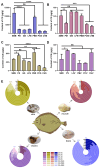Structural Elucidation of Glycosaminoglycans in the Tissue of Flounder and Isolation of Chondroitin Sulfate C
- PMID: 38786589
- PMCID: PMC11123320
- DOI: 10.3390/md22050198
Structural Elucidation of Glycosaminoglycans in the Tissue of Flounder and Isolation of Chondroitin Sulfate C
Abstract
Glycosaminoglycans (GAGs) are valuable bioactive polysaccharides with promising biomedical and pharmaceutical applications. In this study, we analyzed GAGs using HPLC-MS/MS from the bone (B), muscle (M), skin (S), and viscera (V) of Scophthalmus maximus (SM), Paralichthysi (P), Limanda ferruginea (LF), Cleisthenes herzensteini (G), Platichthys bicoloratus (PB), Pleuronichthys cornutus (PC), and Cleisthenes herzensteini (CH). Unsaturated disaccharide products were obtained by enzymatic hydrolysis of the GAGs and subjected to compositional analysis of chondroitin sulfate (CS), heparin sulfate (HS), and hyaluronic acid (HA), including the sulfation degree of CS and HS, as well as the content of each GAG. The contents of GAGs in the tissues and the sulfation degree differed significantly among the fish. The bone of S. maximus contained more than 12 μg of CS per mg of dry tissue. Although the fish typically contained high levels of CSA (CS-4S), some fish bone tissue exhibited elevated levels of CSC (CS-6S). The HS content was found to range from 10-150 ug/g, primarily distributed in viscera, with a predominant non-sulfated structure (HS-0S). The structure of HA is well-defined without sulfation modification. These analytical results are independent of biological classification. We provide a high-throughput rapid detection method for tissue samples using HPLC-MS/MS to rapidly screen ideal sources of GAG. On this basis, four kinds of CS were prepared and purified from flounder bone, and their molecular weight was determined to be 23-28 kDa by HPGPC-MALLS, and the disaccharide component unit was dominated by CS-6S, which is a potential substitute for CSC derived from shark cartilage.
Keywords: HPLC-MS/MS; flounder; glycosaminoglycan; structure properties.
Conflict of interest statement
The authors declare no conflicts of interest.
Figures






Similar articles
-
Quantification and comparison of acidic polysaccharides in edible fish intestines and livers using HPLC-MS/MS.Glycoconj J. 2017 Oct;34(5):625-632. doi: 10.1007/s10719-017-9783-6. Epub 2017 Jul 3. Glycoconj J. 2017. PMID: 28674831
-
Glycosaminoglycans and glycolipids as potential biomarkers in lung cancer.Glycoconj J. 2017 Oct;34(5):661-669. doi: 10.1007/s10719-017-9790-7. Epub 2017 Aug 18. Glycoconj J. 2017. PMID: 28822024
-
Isolation and structural characterization of bioactive glycosaminoglycans from the green-lipped mussel Perna canaliculus.Biochem Biophys Res Commun. 2022 Jul 5;612:50-56. doi: 10.1016/j.bbrc.2022.04.095. Epub 2022 Apr 25. Biochem Biophys Res Commun. 2022. PMID: 35504089
-
Hyaluronic acid and Chondroitin sulfate from marine and terrestrial sources: Extraction and purification methods.Carbohydr Polym. 2020 Sep 1;243:116441. doi: 10.1016/j.carbpol.2020.116441. Epub 2020 May 18. Carbohydr Polym. 2020. PMID: 32532391 Review.
-
Newborn screening and diagnosis of mucopolysaccharidoses.Mol Genet Metab. 2013 Sep-Oct;110(1-2):42-53. doi: 10.1016/j.ymgme.2013.06.007. Epub 2013 Jun 21. Mol Genet Metab. 2013. PMID: 23860310 Free PMC article. Review.
References
-
- Necas J., Bartosikova L., Brauner P., Kolar J. Hyaluronic acid (hyaluronan): A review. Veterinární Medicína. 2008;53:397–411. doi: 10.17221/1930-VETMED. - DOI
MeSH terms
Substances
Grants and funding
LinkOut - more resources
Full Text Sources

